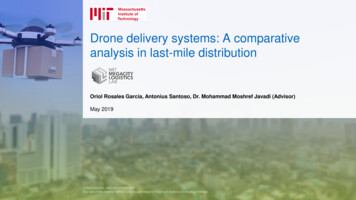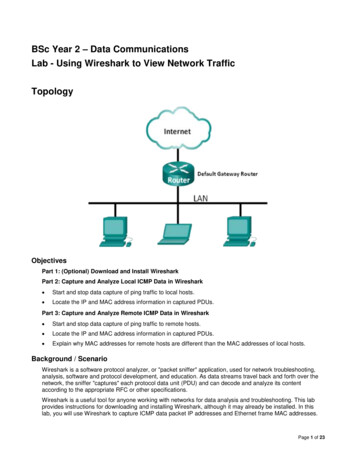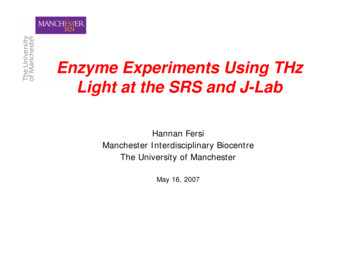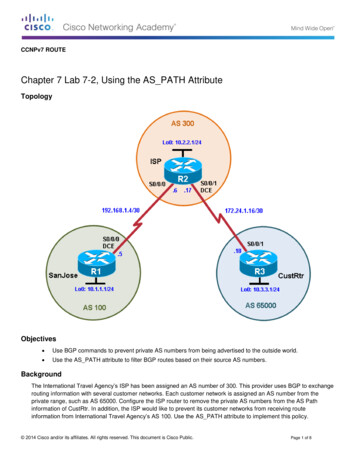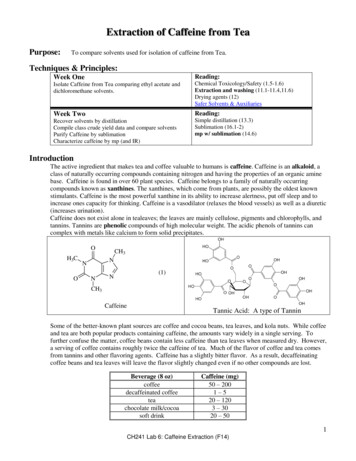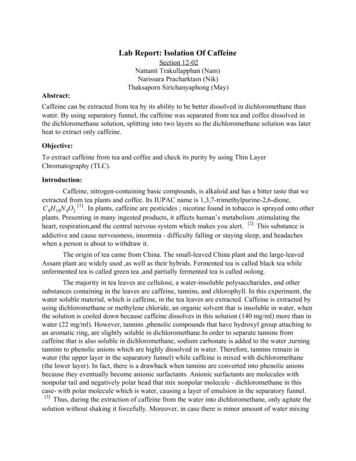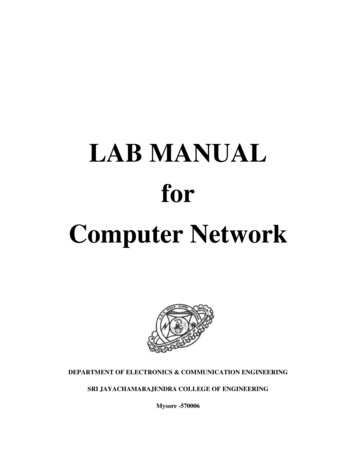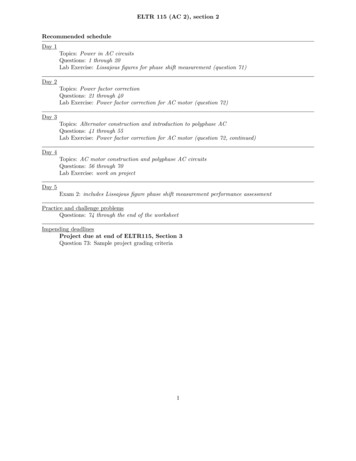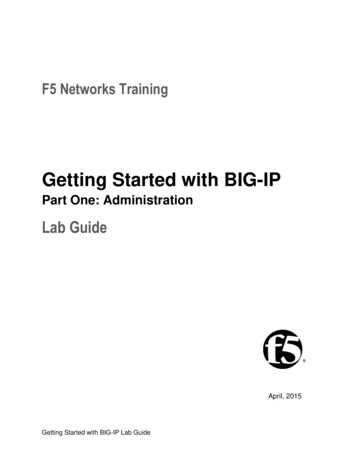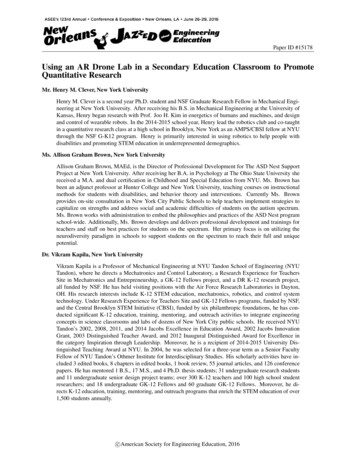
Transcription
Paper ID #15178Using an AR Drone Lab in a Secondary Education Classroom to PromoteQuantitative ResearchMr. Henry M. Clever, New York UniversityHenry M. Clever is a second year Ph.D. student and NSF Graduate Research Fellow in Mechanical Engineering at New York University. After receiving his B.S. in Mechanical Engineering at the University ofKansas, Henry began research with Prof. Joo H. Kim in energetics of humans and machines, and designand control of wearable robots. In the 2014-2015 school year, Henry lead the robotics club and co-taughtin a quantitative research class at a high school in Brooklyn, New York as an AMPS/CBSI fellow at NYUthrough the NSF G-K12 program. Henry is primarily interested in using robotics to help people withdisabilities and promoting STEM education in underrepresented demographics.Ms. Allison Graham Brown, New York UniversityAllison Graham Brown, MAEd, is the Director of Professional Development for The ASD Nest SupportProject at New York University. After receiving her B.A. in Psychology at The Ohio State University shereceived a M.A. and dual certification in Childhood and Special Education from NYU. Ms. Brown hasbeen an adjunct professor at Hunter College and New York University, teaching courses on instructionalmethods for students with disabilities, and behavior theory and interventions. Currently Ms. Brownprovides on-site consultation in New York City Public Schools to help teachers implement strategies tocapitalize on strengths and address social and academic difficulties of students on the autism spectrum.Ms. Brown works with administration to embed the philosophies and practices of the ASD Nest programschool-wide. Additionally, Ms. Brown develops and delivers professional development and trainings forteachers and staff on best practices for students on the spectrum. Her primary focus is on utilizing theneurodiversity paradigm in schools to support students on the spectrum to reach their full and uniquepotential.Dr. Vikram Kapila, New York UniversityVikram Kapila is a Professor of Mechanical Engineering at NYU Tandon School of Engineering (NYUTandon), where he directs a Mechatronics and Control Laboratory, a Research Experience for TeachersSite in Mechatronics and Entrepreneurship, a GK-12 Fellows project, and a DR K-12 research project,all funded by NSF. He has held visiting positions with the Air Force Research Laboratories in Dayton,OH. His research interests include K-12 STEM education, mechatronics, robotics, and control systemtechnology. Under Research Experience for Teachers Site and GK-12 Fellows programs, funded by NSF,and the Central Brooklyn STEM Initiative (CBSI), funded by six philanthropic foundations, he has conducted significant K-12 education, training, mentoring, and outreach activities to integrate engineeringconcepts in science classrooms and labs of dozens of New York City public schools. He received NYUTandon’s 2002, 2008, 2011, and 2014 Jacobs Excellence in Education Award, 2002 Jacobs InnovationGrant, 2003 Distinguished Teacher Award, and 2012 Inaugural Distinguished Award for Excellence inthe category Inspiration through Leadership. Moreover, he is a recipient of 2014-2015 University Distinguished Teaching Award at NYU. In 2004, he was selected for a three-year term as a Senior FacultyFellow of NYU Tandon’s Othmer Institute for Interdisciplinary Studies. His scholarly activities have included 3 edited books, 8 chapters in edited books, 1 book review, 55 journal articles, and 126 conferencepapers. He has mentored 1 B.S., 17 M.S., and 4 Ph.D. thesis students; 31 undergraduate research studentsand 11 undergraduate senior design project teams; over 300 K-12 teachers and 100 high school studentresearchers; and 18 undergraduate GK-12 Fellows and 60 graduate GK-12 Fellows. Moreover, he directs K-12 education, training, mentoring, and outreach programs that enrich the STEM education of over1,500 students annually.c American Society for Engineering Education, 2016
Using an AR Drone Lab in a Secondary Education Classroom to PromoteQuantitative Research1. IntroductionIn recent years, science, technology, engineering, and math (STEM) educators have soughtinnovative ways for integrating technology in teaching and learning to engage and build theinterest of secondary school students in STEM disciplines as well as to capture their imaginationabout STEM careers. Recent technological advancements have allowed design, development,and commercialization of low-cost mini unmanned aerial vehicles (MUAV) that offer a noveland ideal platform to support STEM disciplines in high school classrooms.1 This paper focuseson one illustrative example wherein four sections of a 9th grade quantitative research course,consisting of 25 to 30 students each, were engaged by a graduate researcher through an ARParrot 2.0 (see Figure 1) MUAV-based lab activity, which considered the research question“How fast does the AR Drone fly?” Within the framework of a hands-on lab, the studentsdesigned a MUAV-based controlled experiment, collected their own data, used the collected datato formulate an understanding of the physics, and applied relevant mathematics to reachconclusions. The graduate researcher integrated and examined an array of motivational factors inthe lesson, including the embodiment of quantitative research principles, critical thinking aboutreal-world scenarios, ownership of experimental procedure and outcome, and gamificationwherein students used a video game controller to pilot the MUAV in the experiment. Finally, theMUAV lab targeted the special learning needs of students with autism spectrum disorders (ASD)who composed of 12% of the student body in the school.Figure 1: AR Parrot 2.0
This effort integrated a series of learning elements unique to the structure of the lesson, e.g., asituated cognition model2,3 to frame the experimental activity, a project-based learning4 (PBL)structure in a lab environment, and a social constructivist5,6 approach to bridge the gap betweenthe scientist and the classroom. Specifically, the situated cognition model2,3 was incorporated bythe graduate researcher posing as a member of a university lab that conducts Department ofDefense (DoD) sponsored research. Students were informed that the university lab was preparingto bid on a high-dollar classified MUAV project with a DoD agency and the lab needed students’support in performing preliminary research to generate experimentally validated data for theproposal. This approach produced a contagious excitement and ownership because manystudents in sections following earlier introductory sections knew what to expect; their peers fromearlier sections had shared the idea outside of class. Furthermore, hands-on interactionsembedded in PBL4 allowed students to “do something” to “learn about something,” instead ofthe usual classroom teaching with singular focus on “learn about something.” At the start of theMUAV lesson, students drew names out of a hat to choose between four possible roles: pilotingthe MUAV, timing MUAV flight to measure its ground speed over a set number of parkingspaces located behind the school, recording data, and making experimental observations toexplore sources of error. In a class meeting prior to the day of the experiment, students convenedin their respective groups to discuss how they might perform their roles to achieve the bestpossible results. During post-experiment reporting, students provided answers to the question“How fast does the AR Drone fly?,” culminating in a research presentation and a formal labreport to model activities used in post-secondary level labs.7 Within the experiment, a socialconstructivist approach allowed students to connect past and present experiences in their liveswith the phenomena they observed in the scientific experiment. Research questions were posedin a self-deprecating way with a supposed hesitation of particular answers to provide a fullerunderstanding of the physical world as the students confirmed or rejected their own priorassumptions.Following the lesson, a post assessment was conducted wherein students were given a survey toindicate other types of experiments they might want to conduct using a MUAV. While some ofthe ideas conveyed in the survey are not deemed feasible, others provide an insight into howfuture teachers might design a MUAV lesson plan differently to better capture the interests of thestudents.2. MotivationThe AR Drone lab was integrated into a quantitative research class for 9th grade students. Belowwe discuss how the AR Drone lab design supports the goals of quantitative research in educationand how it promotes mastery of scientific reasoning, which is a fundamental concept in STEMeducation. Scientific reasoning requires understanding and application of both qualitative andquantitative research methods that are offered as two separate required courses in the high school
where the AR Drone lab was implemented. While qualitative research is primarily concernedwith giving detailed descriptions of particular events or process to discover new behaviors orpatterns, quantitative research focuses on developing and testing hypotheses and constructingmodels that explain such behavior or pattern.8Quantitative research has been defined as9 “Explaining phenomena by collecting numerical datathat are analyzed using mathematically based methods (in particular statistics).” This formaldefinition of quantitative research served as the foundational motivation in designing the ARDrone lab and a myriad of other classroom activities including lessons on oil spill cleanup, thefood processing industry, climate change, HIV prevention, etc. While some lessons and activitiesrequired students to analyze pre-collected scientific data from academic sources, others, such asthe AR Drone lab, engaged students to collect their own experimental data. After understandingthe meaning of data, the students applied relevant mathematical methods to support theirarguments. Through basic numerical (addition, subtraction, multiplication, and division) andstatistical (average, median, mode, and range) calculations, the students grasped how, why, andwhen to use a particular mathematical tool to formulate a conclusion.Quantitative research can be further categorized as: 1) experimental or non-experimentalresearch, 2) theoretical or practical research, and 3) descriptive research.8 As delineated below,the AR Drone lab was designed to embody all of these characteristics to give the students a fullerunderstanding of quantitative research. First, the students were guided to design an experimentfor testing the ground speed of the AR Drone. Moreover, they used school computers to researchAR Drone specifications, such as battery life and control features. Second, before experimentingwith the AR Drone, students were taught the theory behind the ground speed and the calculationprocedure using the distance traveled and flying time. Students learned to make judgment callsbased on both practicality and experimental requirements. For example, when posed with anexperimental design question, one student suggested testing the ground speed of the AR Droneby flying it down a street outside the school while another student argued that operating the ARDrone on a busy street will be impractical and pose a danger to public safety. Consequently,students mutually agreed that an empty parking lot behind the school can serve as a feasible testrange. Third, a group of students comprising roughly half of each class were assigned the role ofobservers in the experiment. Each of the observers maintained a notebook to record and describesources of experimental error and other relevant information. Although descriptive research ofaforementioned nature can be construed as qualitative research, such overlap is common andnecessary in designing a successful experiment. Moreover, while working with numerical data, itis vital to include qualitative assessment, with which high school students have greaterfamiliarity, for bridging the link between the two areas to use evidence to support a claim.As recently reported,7 educators have employed the AR Drone to implement a MUAVexperiment, QuadLab, in a post-secondary laboratory learning environment. The success of AR
Drone as an educational platform at the post-secondary level illustrates its potential applicabilityin high school education to reach out to younger students. Similar to the broad appeal of mobilerobotics platforms to students at all levels, the novelty of MUAVs can be used as a hook toengage high school students in STEM learning. Whereas the post-secondary MUAV lab focuseson topics such as communication, robotic design, and automation and control, this high schoollevel AR Drone lab focuses on quantitative thinking, experimental design, project-basedlearning,10 and common core math standards.11Similar to Ref. 7, the AR Drone was selected due to its ease of use, low cost, safety, andreliability. The AR Drone costs 300, it can be readily purchased off-the-shelf at mainstreamretailer outlets, there is a foam surround to shield foreign objects from the rotors, and opensource software for control via a joystick gaming controller is readily available, easy to install,and allows reliable operation of the AR Drone. A down-facing ultrasonic sensor that detectsground distance allows the AR Drone to be easily landed with the click of a single button on thegaming controller, regardless of the flying speed or height. This ease of operation allows student“pilots” to easily complete experimental trials while staying engaged and feeling in control.The quantitative research methods course provided motivation to engage students in gaining adeeper grounding in error and how it affects the AR Drone lab experiment. While Ref. 7 usedembedded technology of the AR Drone software development kit to collect data such as flighttime, we opted to assign students roles as “flight timers” with stop watches. In addition tokeeping students more engaged, this purposefully introduced a source of error that the studentscould later analyze using statistics.The educational QuadLab7 introduced a custom graphical user interface (GUI) on a computer forstudents to control the MUAV. While such an approach is suitable at the post-secondaryeducation level, we concluded that the complexities entailed in interacting with and interpretingthe multiple buttons and graphs of the GUI might confuse students at the secondary educationlevel. To circumvent this problem and to further engage the high school students, we weremotivated to employ a method of gamification12 in operating the MUAV.The AR Drone lab was an integrated classroom, a setting in which general education and specialeducation peers worked and learned together. Therefore the lab was filled with diverse learnerswith varied skill sets, learning styles, strengths, and challenges. In particular, a subset of thisclass was composed of students diagnosed with ASD. Gamified activities can be particularlychallenging since the criteria for ASD diagnosis includes clinically significant, persistent deficitsin social communication and interactions across contexts.13 However, the AR Drone lab taps intoareas of students’ special interest, thus increasing the likelihood of social engagement. In onecase, researchers framed a summer camp around robotics to decrease social anxiety amongadolescents with ASD.14 Research has shown that a substantial percentage of students with ASD
develop deep interests in STEM topics, and have abilities that are well-suited to STEMcoursework and careers, e.g., the ability to engage in systems thinking, to concentrate for longperiods on complex topics, and to pay close attention to detail.15,16Students with ASD, even those who have interests in academic topics, can fall off the pathway toprofessional careers because successfully navigating the process of preparing for and succeedingin college and careers requires more than academic ability.17 Skills such as socialcommunication, organization, and collaboration are some of the abilities necessary to succeed atthe post-secondary level. It is essential to build and practice these skills early on becausepostsecondary success is dependent on the habits of mind that students develop, the academiccourses they take, and the extracurricular activities they pursue from the beginning of highschool.18 Extracurricular activities, specifically participation in sports teams, provide ampleopportunity to develop collaborative and social communication skills. However, participation insports tend to require motor control and several studies have reported on the motor controldifficulties in children with ASD, including how proprioceptive difficulties among children withASD may contribute to decreased motor planning and to disruptive behaviors that negativelyaffect their participation in daily tasks.19 Thus, participation in STEM based gamified activitiescan serve as an alternative opportunity to develop collaborative and social communication skills.The AR Drone lab affords students with ASD a chance to participate in an activity based on theirinterest while also providing an opportunity to develop the critical social skills for future success.3. Learning Elements3.1. Project-Based Learning in a Laboratory EnvironmentA widely used pedagogical tool in STEM classrooms is PBL.4 One key attribute of PBL is“doing something” to “learn about something,” instead of the usual classroom teaching withsingular focus on “learning about something.” This interactive technique allows teachers tocapture students’ attention by finding an element of fun in the task they are learning.“In every job that must be done, there is an element of fun.You find the fun and – SNAP – the job’s a game.” – Mary Poppins“Doing something” is commonly associated with activity, enjoyment, and engagement.Effectively incorporating this into the STEM classroom through PBL promotes learning ideals sothat students may successfully collect numerical data while doing something they enjoy toachieve lesson plan goals in a quantitative research class. Moursund4 highlights six ways inwhich PBL may be analyzed from a student’s point of view. We can directly apply these toevaluate the constituents of the AR Drone lesson.
1. Learner centered, intrinsically motivating: Before conducting the experiment, the studentsdrew names out of a hat for selecting four possible roles: piloting the drone, timing the droneflight to measure its ground speed over a set number of parking spaces located behind the school,recording data, and making experimental observations to explore sources of error. As learnersperformed these key roles, they controlled the outcome of the experiment. Learners were givenan opportunity to critique the suggested initial parameters for experiment provided by thegraduate researcher, such as how many parking spaces the AR Drone would fly over and whenthe timers would start and stop the timing: would they start the timing when the AR Dronebegins to hover or when it begins to fly forward? This ownership of the experimental processcenters the focus on the learners by allowing them to modify, or “tweak” their role. For reasonspreviously stated, gamification of this experiment was intrinsically motivating as was the noveltyof controlling a MUAV.2. Collaboration and cooperative learning: On the day before the experiment, the students weredivided in the groups of their respective role and given ample time in class to meet and discusshow they might approach the experiment as a whole. Likewise, they had 10 minutes toexchange thoughts at the parking lot just prior to beginning the experiment when theirexcitement was building. In between each trial, the graduate researcher instructed each group tothink critically out loud about the previous trial and how their role affected it. As a result thestudents cooperated to learn how th
through the NSF G-K12 program. Henry is primarily interested in using robotics to help people with disabilities and promoting STEM education in underrepresented demographics. Ms. Allison Graham Brown, New York University Allison Graham Brown, MAEd, is the Director of Professional Development for The
